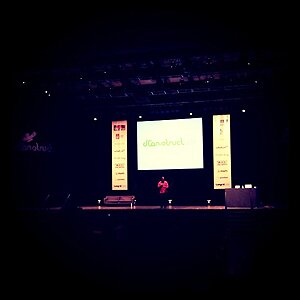
During our free time at Artlines we planned and put together a coffee arcade table, we’re proud of it and we thought we’ll share how we done it.
Shopping list
- 2 x Joysticks
- 16 x buttons (12 action, 2 coin and 2 player start buttons)
- I-PAC PC keyboard interface
- Crimps
- Wire
- Monitor
- Computer
- Speakers
- Table
- Wood
- Foam

We bought in our table that we could easily modify, our table was a simple black gloss style 1000 × 450mm. Taking these measurements into illustrator the button holes and screen placement was put into place. The file was saved and used as a template by the perspex company to cut the holes needed.

Once the perspex was complete we fitted this to the top of the table using quick release clamps.
Tom then began routing the wood using the perspex as a guide, the holes created by this were identical to the perspex – what a great tool!

The table used honeycomb corrugated cardboard on the inside to create stability and strength, we pushed the cardboard out of the way where needed to clear the button holes.

Measuring out the centre of the table and correct placement for the monitor was simple using a ruler and masking tape, once in the centre Tom clamped in the router to drill out perfect lines. The table was then turned over and the same measurements were drawn out and masked for cutting out, we then used a knife to cut deeper through the cardboard and the middle screen block fell out with a hard push.
For the back of the buttons we needed a bit of space to fiddle with the wiring so a large block was cut out to do so.

The joysticks came with a metal plate to screw in, we used this metal plate as a template to drill holes through. These holes were then countersunk into the wood which allowed us to secure the joysticks from the underside not needing the metal plate at all.

Using the illustrator template we had vinyl custom cut to measure with the screen area and button holes cut also, the screen had a little overhang to hide all the brands and buttons. The vinyl was carefully placed on the table and then the perspex was placed back on top, make sure to dust free any little particles!
We peeled back the corners and firmly secured the perspex to the wood table.

As we started to peel the perspex cover sheet back we got excited and placed in all the buttons and joysticks, all that was left to do was securing the monitor and wiring all the buttons.

Using blocks of wood and cut out pieces of foam we secured the monitor into place, the monitor cables were eventually cable tied to secure them down.

Wiring took no longer than 20 minutes, quickly cutting each wire to the correct length and crimping one end that was placed on the joystick/button. This was done for every button and wired into the I-PAC, this translates the arcade buttons into keyboard commands. Each button needed to be grounded down or else it will fail as its pressed, the tidiest way of grounding was to chain all the ground wires together hopping from one to the other.
Once all the buttons we’re complete we needed to setup the buttons on the computer, plugging in the computer, monitor and speakers was a nervous time! The machine booted up fine and we were greeted by the Windows XP welcome screen.
Firing up MAME we set up Player 1 and Player 2 controls, then it was testing time…

Street Fighter battle!
Everything worked perfectly and better than we imagined – great success!
P.S Challenges accepted!




